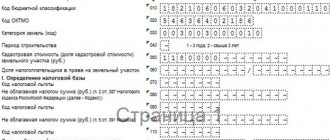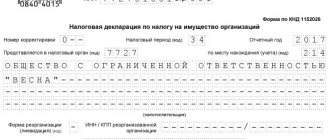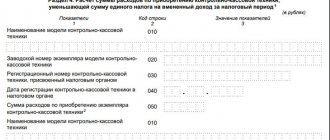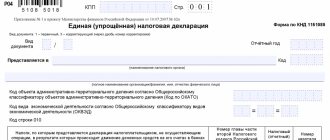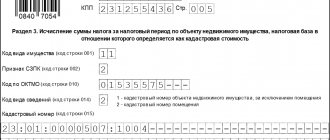There is very little time left to submit your land tax return. And this year there is also a new form of land tax declaration. Let's talk about everything in order.
Only tax payer organizations are required to report on land tax. These are companies that own or permanently use land. When renting or free use of land, you do not need to pay tax.
Our article is about how to fill out a land tax return for 2021.
Land tax declaration: deadlines
The declaration should be submitted when the tax period ends, i.e. calendar year. The declaration is submitted to the Federal Tax Service at the location of the land plot, and the largest taxpayers submit it at their place of registration.
Firms that have several plots located on the territory subordinate to one Federal Tax Service, submit a land tax declaration in one copy, and each object must be reflected on a separate sheet of Section 2. And if the territories where the plots are located belong to different inspections, then the declarations are also submitted for each separately (letter of the Federal Tax Service of the Russian Federation dated 08/07/2015 No. BS-4-11/13839).
The submission deadline is annually, no later than February 1 of the year following the reporting year. Organizations need to report for 2021 no later than February 1, 2021.
If the land tax return is submitted late, the organization will be fined, and the fine for each month of “delay” will be 5% of the tax unpaid according to the return, but not more than 30% in the amount and not less than 1000 rubles. (clause 1 of article 119 of the Tax Code of the Russian Federation).
Electronic filing of the declaration is mandatory for organizations with an average number of employees over 100 people; others have the right to report on paper (clause 3 of Article 80 of the Tax Code of the Russian Federation).
If the three-year construction period has expired
As already mentioned, according to the changes made, at the end of the three-year period for housing construction during the tax period, two sections must be filled out separately. 2 declarations with different coefficients.
At the end of the tax period, taxpayers-organizations submit a declaration to the tax authority at the location of the land plot. Taxpayers classified as the largest taxpayers submit declarations to the tax authority at the place of registration as the largest taxpayers.
Accordingly, if during the tax period coefficient 2 is replaced by coefficient 4, applied when calculating land tax in relation to a land plot acquired (provided) into the ownership of a legal entity under the terms of housing construction on it, according to line code 040 of one sheet of section. 2 indicates the value 1, and on the line with code 040 of the second sheet of section. 2 – value 2.
In this situation, according to the line with code 130 section. 2 reflects the number of full months of ownership of the land plot in the tax period, taking into account the construction period specified in the line with code 040 section. 2.
Let us recall that the number of full months when ownership of a land plot arises is calculated as follows ( clause 7 of Article 396 of the Tax Code of the Russian Federation ):
– if the emergence of ownership of a land plot occurred before the 15th day of the corresponding month inclusive, or the termination of the said right occurred after the 15th day of the corresponding month, the month of emergence (termination) of this right is taken as the full month;
– if the emergence of ownership of a land plot occurred after the 15th day of the corresponding month or the termination of the specified right occurred before the 15th day of the corresponding month inclusive, the month of emergence (termination) of this right is not taken into account.
If the three-year construction period ends, the same approach is used to determine the full months.
In addition, according to the line with code 140 section. 2 (coefficient Kv) reflects the ratio of the number of full months of ownership of a land plot in the tax period, taking into account the construction period entered in the line with code 040 section. 2, to the number of calendar months in the tax period.
Source:
Ayudar Info
Heading:
Land tax
preparation and submission of reports land tax declaration land tax instructions for an accountant
- E. Zobova, editor of the magazine “Topical Issues of Accounting and Taxation”
Sign up 8645
12350 ₽
–30%
The new land tax declaration form includes:
- Title page,
- Section 1 – the amount of tax payable to the budget,
- Section 2 – calculation of the base and amount of land tax.
Text fields are filled in in printed capital letters, and cost indicators are indicated in full rubles, taking into account rounding rules: discarding the amount up to 50 kopecks, and 50 kopecks. and more, rounded to the nearest ruble. If there is no indicator in the cells, a dash is placed.
When submitting a land tax return 2017 in a “paper” format, the report is printed on only one side of the sheet, and all pages are numbered consecutively. A stapler is not used to fasten sheets together, and a proofreader cannot be used to correct errors.
Section 1. The amount of land tax payable to the budget
Section 1 of the declaration is filled out by the organization for all land plots located within the relevant municipalities (shares of land plots located within the boundaries of the relevant municipalities (federal cities of Moscow, St. Petersburg and Sevastopol), shares in the right to a land plot).
Attention! Section 1 is formed only after filling out section 2 and almost all of its indicators (except for advance payments) are filled in automatically based on the information reflected in section 2.
Attention! If an organization is a participant in subsoil resources provided for use under the terms of a production sharing agreement (PSA), then in a specially designated field it indicates the name of the production sharing agreement.
This section includes separate blocks of lines 010-040 , which reflect the following information:
- line 010 - budget classification code (BCC) , in accordance with which land tax must be paid (automatically transferred from line 010 of section 2);
- line 020 - code according to OKTMO , according to which the amount of tax is payable (automatically transferred from line 020 of section 2);
- line 021 - calculated amount of tax payable to the budget for the tax period (automatically transferred from line 250 of section 2 according to the corresponding codes KBK and OKTMO);
- lines 023, 025, 027 - amounts of advance payments payable to the budget for the 1st, 2nd and 3rd quarters (calculated by the organization);
- line 030 - the amount of tax payable to the budget at the place of submission of the declaration according to the corresponding codes KBK and OKTMO (calculated automatically);
- line 040 - the amount of tax calculated for reduction based on the results of the tax period (calculated automatically).
Attention! Advance payments for land tax are not paid if this obligation is not provided for by the regulatory legal acts of the representative bodies of municipalities. In this case, lines 023, 025 and 027 are not filled in.
The value of the indicator “Amount of tax payable to the budget” according to the corresponding codes KBK and OKTMO is determined automatically as the difference between the calculated amount of land tax payable to the budget for the tax period and the amounts of advance payments transferred to the budget during the tax period. If the calculated value is negative, then 0 is automatically indicated in this column, i.e.
page 030 = page 021 – (page 023 + page 025 + page 027) according to the corresponding codes KBK and OKTMO, provided that page 030 > 0
A negative value of the indicator “Amount of tax payable to the budget” indicates that the amount of advance payments transferred by the organization exceeds the amount of land tax calculated for the tax period and in this case the indicator “Amount of tax calculated for reduction” , i.e.
page 040 = page 021 – (page 023 + page 025 + page 027) according to the corresponding codes KBK and OKTMO, provided that page 040 < 0
Also in section 1, in the field “I confirm the accuracy and completeness of the information specified on this page,” the date is automatically indicated.
Filling out a land tax return
The declaration is filled out taking into account the requirements of the rules contained in Appendix No. 3 to Order No. MMV-7-21/347. All necessary codes are included in appendices No. 1-6.
Title page
Filling out the title is traditional: at the top of the page (and on each completed sheet) indicate your TIN, checkpoint and serial number of the page.
The adjustment number is “0—” for the primary report, and when submitting an updated declaration – “2—”, “3—”, etc.
The tax period code is “34”, and for companies reporting in connection with liquidation/reorganization – “50”. Year – “2017”.
Next, indicate the code of the Federal Tax Service where the declaration is submitted, and the submission code at the location of the land - “270”. The name of the organization is indicated in full without abbreviations.
The date and signature of the taxpayer (manager) or his representative are placed at the bottom.
Section 2
First, you need to calculate the tax, for which we will fill out section 2 of the “land tax 2017” declaration for legal entities.
The tax base is calculated separately for each object - a plot of land, a share of a plot, or a share in the right to it. To do this, you need to fill out several sections 2, according to the number of taxable objects of the organization.
In the first lines, indicate the cadastral number of the land.
BCC (line 010) is indicated by the location of the site: within the boundaries of cities, villages, etc.
The OKTMO code (line 020) corresponds to the municipality on whose territory the land plot is located.
The land category code (line 030), according to its purpose, is selected from Appendix No. 5.
Line 040 is filled in by companies carrying out construction on the site.
The cadastral value (line 050) is taken into account as of January 1 of the reporting year. The cost of the plot in the land tax return for 2021 is taken as of 01/01/2017.
Line 060 is filled in as a simple fraction, indicating the share in the right to the plot.
Next, in subsection I the tax base is calculated: on lines 070-100 the codes and amount of tax benefits (non-taxable amount, or area), if any, and on line 110 - the cadastral value as of 01/01/2017, or the standard price of land.
In subsections II and III, we will calculate the amount of tax: indicate the tax rate in force at the location of the site (line 120) and the number of full months of ownership of this land in 2021 (line 130). If the plot was owned for an incomplete tax period, then it is necessary to apply the coefficient (line 140), calculated in accordance with clause 5.16 of the Procedure for filling out the declaration.
The tax amount (line 150) is determined as the product of lines 110, 120 and 140, divided by 100.
Lines 160 – 240 are filled out if appropriate benefits are available.
The final amount of tax payable (line 250) is reflected as the difference between the tax (line 150) and benefits (lines 190, 210, 230).
Section 1
The obtained result is transferred to the blocks of lines in Section 1 for each land plot, indicating the corresponding BCC and OKTMO.
We take the calculated tax (line 021) from line 250 of section 2. On lines 023-027 we will reflect advance payments payable during the year.
The difference between tax and advances is reflected in line 030 if the result is positive, or 031 if negative. Below you can see an example of filling out a land tax return for 2017.
Where are fiscal reporting submitted?
Art. 398 of the Tax Code of the Russian Federation states that the completed declaration must be sent to the Federal Tax Service at the address of the location of the plot of land.
Difficulties arise if a company or private merchant owns several plots in different territorial units. The following options are possible:
- The areas are located within one city (settlement) and under the jurisdiction of one Federal Tax Service. A legal entity submits to the tax authorities one land tax return for 2021, in which a number of second sections equal to the number of plots are completed.
- Allotments are located within the same municipality, but fall under the jurisdiction of different fiscal authorities. The taxpayer has the right to submit one report to the selected tax office with information on all areas, notifying the rest by any letter. This option is controversial, because the Federal Tax Service may insist on receiving its “own” form. In order to avoid being drawn into lengthy proceedings, it is recommended to agree in advance on the procedure with the regulatory authorities.
- If the lands are located in different settlements, but fall under the jurisdiction of one fiscal structure, one declaration with the required number of sections No. 2 is submitted.
- If the plots are located in different settlements controlled by several tax authorities, “its own” reporting is prepared for each Federal Tax Service.
A special rule applies to organizations and individual entrepreneurs recognized as the largest taxpayers. They submit a declaration to the Federal Tax Service from which they received notification of assignment of the appropriate status. It does not matter how many plots they own and where their lands are geographically located (Article 398 of the Tax Code of the Russian Federation).
Rules and procedure for filling out the form
When filling out the title page, the organization's accountant will not have any questions. It indicates basic information and codes for the company.
The declaration begins to be filled out from the second section, which is called “Calculation of the tax base and tax amount”:
- Filling out and calculation is carried out separately for each plot of land or share in land ownership with the obligatory indication of the cadastral number. The number is filled in in a separate field.
- A mandatory field to fill out is the Budget Classification Code (BCC), it is according to its data that the tax payment will fall on the necessary details.
- The OKTMO code is filled in - this is a sign of the territory of the municipality on which the land object is located.
- A special code for the territory of the land is entered in line 030.
- Line 040 indicates the value 2 or 1. Data about the territory where housing construction is being carried out appears here. This should only be done by legal entities. Plots built up by individuals with buildings for individual use are not included in this line. The number 2 is set if construction is planned to take place for more than three years. Indicator “1” indicates that the construction period does not exceed three years.
- Enter data on the cadastral value of the plot (information is determined as of January 1 of the reporting year) in field 050.
- Next, the taxpayer’s share in the ownership of the site and, if necessary, a tax benefit are indicated. If there is a benefit, then the section further includes data on amounts that reduce the tax base and are not subject to taxation. And as a result, the final tax base falls into line 130.
- It is necessary to enter in line 150 the number of full months during which the taxpayer owned the property.
- Line 170 indicates the amount of tax payable for a specific object.
Documents for download (free)
- Land tax declaration form
- Example of filling out a declaration
You can watch the process of filling out the form in the 1C program in the following video:
How to fill out a declaration
We will show you how an organization fills out a new land tax declaration form using a numerical example.
EXAMPLE.
HOW TO COMPLETE A LAND TAX DECLARATION Let's assume that Vector LLC acquired a plot of land located on the territory of Arkhangelsk on July 10, 2017, for the temporary placement of a parking lot. The cadastral number of the plot is 14:10:14538:0005 (conditional). As of 01/01/2017, the cadastral value of the land (line 050 of section 2) is equal to 1,250,000 rubles. The plot was purchased before July 15, therefore July is recognized as a full month, and the coefficient Kv (line 140 of section 2) is equal to 0.5 (6: 12). Vector LLC has no benefits for this site, therefore the tax base (line 110 of section 2) is 1,250,000 rubles, and the K coefficient (line 170 of section 2) is equal to 1.0. The tax rate (line 120 of section 2) in relation to such plots is equal to 1.5 percent. The tax amount for the year (line 250 of section 2) is: RUB 1,250,000. × 1.5 × 0.5: 100 = 9375 rubles. In 2021, Vector LLC made an advance payment for the third quarter (line 027 of section 1) in the amount of 4688 rubles. (RUB 1,250,000 × 1.5: 4: 100). Thus, the land tax that must be paid additionally for this plot (line 030 of section 1) is 4,687 rubles. (9375 rubles – 4688 rubles).
Follow the link to see a sample of filling out a land tax return.
